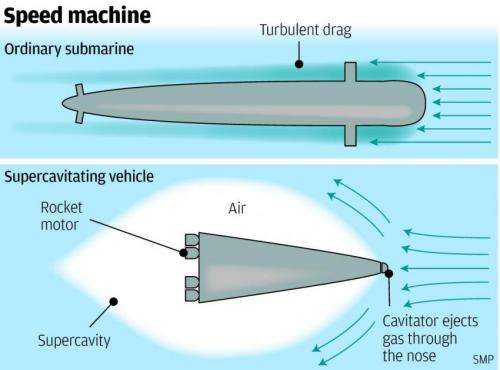August 27, 2014 weblog
China team takes on tech challenge of supercavitation

Shanghai passenger to captain: Excuse me sir, how long until we reach San Francisco? I don't know if I have enough time to watch a movie. Captain: You might just make it. A little under two hours.
Rub your eyes but a headline on Sunday in the South China Morning Post (SCMP) remains, "Shanghai to San Francisco in 100 minutes by Chinese supersonic submarine." That could be the case that results from ongoing research among scientists. Stephen Chen reported on Sunday that China has moved a step closer to creating a supersonic submarine that could make the trip from Shanghai to San Francisco in less than two hours..
This could indeed be part of the future of underwater travel. Scientists in China are exploring how supercavitation could get people where they want to go. During the cold war, said Chen, the Soviet military developed supercavitation technology, which involves enveloping a submerged vessel inside an air bubble to avoid problems caused by water drag. "A Soviet supercavitation torpedo called Shkval was able to reach a speed of 370km/h or more - much faster than any other conventional torpedoes," he said.
A paper from Caltech by Victoria Sturgeon in 2001 titled Racing Through Water: Supercavitation referred to the Shkval torpedo as an underwater missile that shatters speed records by using a phenomenon known as supercavitation. She said that it was first explored in the 1940s. The interest in supercavitation is due to how it exploits a loophole that allows underwater travel with minimal drag. "In supercavitation,"she explained, "the small gas bubbles produced by cavitation expand and combine to form one large, stable, and predictable bubble around the supercavitating object."
Then why has this concept of underwater travel in a bubble remained out of the limelight for so long? Sturgeon wrote that although supercavitation has been widely studied since the 1940s, many questions remain unanswered.
The SCMP highlighted two problems in supercavitation technology. First, the submerged vessel needed to be launched at high speeds, approaching 100km/h, to generate and maintain the air bubble. Secondly, it is difficult if not impossible to steer the vessel using conventional mechanisms, which are inside the bubble, without direct contact with water. As a result, its application has been limited to unmanned vessels, fired in a straight line.
Li Fengchen, professor of fluid machinery and engineering, told SCMP that the group's approach differs from any other approach such as vector propulsion or thrust created by an engine. "By combining liquid-membrane technology with supercavitation," he said, "we can significantly reduce the launch challenges and make cruising control easier." Nonetheless, Li said many problems still needed to be solved before supersonic submarine travel became feasible.
Cheng said the group, whose research is ongoing, is hardly alone in exploring the possibilities of such modes of travel. He said many scientists worldwide are working on similar projects, but "the latest progress remains unclear because they are regarded as military secrets."
More information: www.scmp.com/news/china/articl … supersonic-submarine
© 2014 Tech Xplore
















